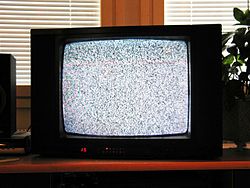- Noise (video)
-
 On an empty channel, an analog TV receiver shows a "snowy" noise pattern. A similar pattern is shown if on a digital channel when not using a DTV converter box.
On an empty channel, an analog TV receiver shows a "snowy" noise pattern. A similar pattern is shown if on a digital channel when not using a DTV converter box. An old black and white receiver showing noise.
An old black and white receiver showing noise.
Noise, in analog video and television, is a random dot pattern of static displayed when no transmission signal is obtained by the antenna receiver of television set and other display devices. The random pattern superimposed on the picture, visible as a random flicker of "dots" or "snow", is the result of electronic noise and radiated electromagnetic noise accidentally picked up by the antenna, which, by the way, is received form outer space. This effect is most commonly seen with analog TV sets or blank VHS tapes.
There are many sources of electromagnetic noise which cause the characteristic display patterns of static. Atmospheric sources of noise are the most ubiquitous, and include electromagnetic signals prompted by cosmic microwave background radiation[1], or more localized radio wave noise from nearby electronic devices[2].
The display device itself is also a source of noise, due in part to thermal noise produced by the inner electronics. Most of this noise comes from the first transistor the antenna is attached to.[3]
Due to the algorithmic functioning of a digital television set's electronic circuitry and the inherent quantization of its screen, the "snow" seen on digital TV is less random.[4]
UK viewers used to see "snow" on black after sign-off, instead of "bugs" on white, a purely technical artifact due to old 405-line British receivers using positive rather than the negative video modulation used in Canada, the U.S., and (currently) the UK as well.
Most modern televisions automatically change to a blue screen or turn to standby after some time if static is present.
Since one impression of the "snow" is of fast-flickering black bugs on a cool white background, in Sweden, Denmark and Hungary the phenomenon is often called myrornas krig in Swedish, myrekrig in Danish and hangyák háborúja in Hungarian, which translate to "war of the ants" or sometimes hangyafoci which means "ant soccer", and in Romanian, purici, which translates into "fleas".[5]
See also
References
- ^ http://www.nasa.gov/vision/universe/starsgalaxies/cobe_background.html Background on the Background Explorer and the Science of John Mather. Retrieved 9 May 2011.
- ^ http://www.hdtvprimer.com/ANTENNAS/basics.html
- ^ http://www.hdtvprimer.com/ANTENNAS/basics.html
- ^ WonderQuest: Fast answers
- ^ Munck, Anders (2007-09-23). "Tv-brus bra för barn med ADHD" (in Swedish). SvD. http://www.svd.se/nyheter/inrikes/artikel_207939.svd. Retrieved 2007-07-31.
Noise (in physics and telecommunications) General Noise in... Class of noise Additive white Gaussian noise (AWGN) · Atmospheric noise · Background noise · Brownian noise · Burst noise · Cosmic noise · Flicker noise · Gaussian noise · Grey noise · Jitter · Johnson–Nyquist noise · Pink noise · Quantization error (or q. noise) · Shot noise · White noiseEngineering terms Ratios Carrier-to-noise ratio (C/N) · Carrier-to-receiver noise density (C/kT) · dBrnC · Eb/N0 (energy per bit to noise density) · Es/N0 (energy per symbol to noise density) · Modulation error ratio (MER) · Signal, noise and distortion (SINAD) · Signal-to-interference ratio (S/I) · Signal-to-noise ratio (S/N, SNR) · Signal to noise ratio (imaging) · Signal-to-noise plus interference (SNIR) · Signal-to-quantization-noise ratio (SQNR)Related topics Categories:- Noise
- Television terminology
- Technology stubs
Wikimedia Foundation. 2010.
